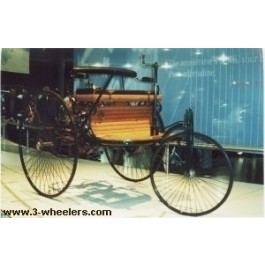Browse By
|
BenzDescriptionAccepted as the inventor of the motor car Karl Benz first unveiled his Benz 3-wheeler in 1885 at Mannheim. (Germany) The vehicle was powered by a water cooled gas engine that was driven by the vapour of ligroin, or benzine. The rear wheels received the power by a pulley and belt that were attached to a transmission shaft whilst the water cooling was by water evaporation in a jacket round the cylinder. Despite inventors like Gottlieb Daimler who worked on 4-wheeler designs, Benz stuck to a 3-wheeled design for many years producing many vehicles but in the days before tarmac roads, many common place roads consisted of two rutted tracks left by horse drawn coaches. Whilst the 4-wheeler would often run in these ruts the front wheel of a 3-wheeler was running on uneven ground creating a bumpy ride and placing great stress on the structure of the vehicle itself. Benz had initially designed his vehicle as a 3-wheeler to overcome problems with steering. While Karl Benz is accepted as the inventor of the motorcar, Gottlieb Daimler is accepted as the inventor of the motorcycle. On November 10 1885, the first test ride of what is often considered the first modern motorcycle, the Daimler Reitwagen (“riding car”), occurred. At the controls was 17-year-old Paul Daimler, son of the bike’s inventor, Gottlieb Daimler. This journey effectively made Paul the world’s first biker. Here is the Daimler Reitwagen:  By 1926, the inventor of the motorcar and the inventor of the motorcycle would merge their two companies. Daimler-Benz was formed in 1926 by the merger of two pioneering German automobile companies, one founded by Karl Benz, the other by Gottlieb Daimler. Both Benz and Daimler claimed to have invented the gasoline-powered auto engine. The Hildebrand & Wolfmüller was the world's first production motorcycle. Heinrich and Wilhelm Hildebrand were steam-engine engineers before they teamed up with Alois Wolfmüller to produce their internal combustion Motorrad in Munich in 1894. Their Motorrad is pictured below.  Detailed Information
|



